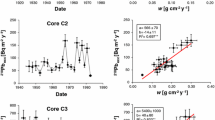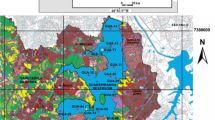Abstract
Much discussion has centered around which 210Pb dating method should be used, the constant initial concentration (CIC) model or the constant rate of supply (CRS) model. In this study, the activity data from 22 lacustrine sediment cores from the Canadian prairies were used to compare the determination of sediment accumulation using the two models. Other relative and absolute dating techniques have been used to calibrate the methodology. For half of the core sites examined, the mass sedimentation rate was constant, and thus both the CIC and CRS models were found to be valid. For the other half, variability was observed in the CRS mass accumulation rate trend. The validity of the CIC model for these cores was dependent on the degree of variability of the mass sedimentation rate. Where the variability is moderate to high, the CRS model may be more satisfactory. Caution should be exercised when using chronological data determined with the CRS model, however, as the accuracy of chronology in the lower reaches of a profile is questionable.
Similar content being viewed by others
References
Appleby PG and Oldfield F (1978) The calculation of 210Pb dates assuming a constant rate of supply of unsupported 210Pb to the sediment. Catena 5:1–8
Appleby PG and Oldfield F (1983) The assessment of 210Pb data from sites with varying sediment accumulation rates. Hydrobiologia 103:29–35
Appleby PG, Oldfield F, Thompson R, Huttunen P, and Tolonen K (1979) 210Pb dating of annually laminated lake sediments from Finland. Nature 280:53–55
Appleby PG, Nolan PJ, Oldfield F, Richardson N, and Higitt SR (1988) 210Pb dating of lake sediments and ombrotrophic peats by gamma assay. Sci Total Environ 69:157–177
Appleby PG, Richardson N, Nolan PJ, and Oldfield F (1990) Radiometric dating of the United Kingdom SWAP sites. Phil Trans R Soc London B 327:233–238
Armentano TV and Woodwell GM (1975) Sedimentation rates in Long Island marsh determined by 210Pb dating. Limnol Oceanogr 20:452–455
Battarbee RW, Appleby PG, Odell K, and Flower RJ (1985) 210Pb dating of Scottish lake sediments, afforestation and accelerated soil erosion. Earth Surf Process Landform 10:137–142
Benninger LK, Lewis DM, and Turekian KK (1975) The use of natural 210Pb as a heavy metal tracer in the river-estuarine system. In: Church TM (Ed), Marine Chemistry in the Coastal Environment. Washington, DC: ACS Symposium Series 18, pp 202–210
Benninger LK, Aller RC, Cochran JK, and Turekian KK (1979) Effects of biological sediment mixing on the 210Pb chronology and trace metal distribution in a Long Island Sound sediment core. Earth Planet Sci Lett 43:241–259
Bruland KW, Koide M, Bowser C, Mäher LJ, and Goldberg ED (1975) Lead-210 and pollen geochronology on Lake Superior sediments. Quat Res 5:89–98
Christensen ER and Goetz RH (1987) Historical fluxes of particle-bound pollutants from deconvolved sedimentary records. Environ Sci Technol 21:1088–1096
Davis RB, Hess CT, Norton SA, Hanson DW, Hoagland KD, and Anderson DS (1984) 137Cs and 210Pb dating of sediments from soft-water lakes in new england (USA) and Scandinavia, A failure of 137Cs dating. Chem Geol 44:151–185
Delorme LD (1991) The preparation of lacustrine sediment samples from cores for use in dating and paleolimnology. Burlington, Ontatio. National Water Research Institute Contrib 92–188, 18 pp
Eakins JD and Morrison RT (1978) A new procedure for determination of lead-210 in lake and marine sediments. Int J Appl Radiation Isot 29:531–536
Esterby SR and El-Shaarawi AH (1981a) Inference about the point of change in a regression model. Appl Stat 30:277–285
Esterby SR and El-Shaarawi AH (1981b) Likelihood inference about the point of change in a regression regime. J Hydrol 53:17–30
Evans JE, Johnson TC, Alexander EC, Lively RS, and Eisenrich SJ (1981) Sedimentation rates and depositional processes in Lake Superior from 210-Pb geochronology. J Great Lakes Res 7:299–310
Evans RD and Rigler FH (1980) Measurement of whole lake sediment accumulation and phosphorus retention using lead-210 dating. Can J Fish Aquat Sci 37:817–823
Evans RD and Rigler FH (1983) A test of lead-210 dating for the measurement of whole lake soft sediment accumulation. Can J Fish Aquat Sci 40:506–515
Goldberg ED (1963) Geochronology with lead-210. In: Radioactive Dating. Vienna: International Atomic Energy Agency, pp 121–131
Harper NS and Delorme LD (1988) Palynology of Hamilton Harbour sites 8A and 12B (cores 137 and 138) Ontario. Burlington, Ontario: National Water Research Institute Tech Note LRB-88-8. 17 pp
Holloway L and Delorme LD (1984) Specific gravity determinations of sediment from Lonetree and Humboldt Lakes, Saskatchewan. Burlington, Ontario: National Water Research Institute Tech Rept AED-85-6. 22 pp
Holloway L and Delorme LD (1985a) Specific gravity determinations of sediments from Alberta lake cores (110, 112, 113, 114, 116, 117). Burlington, Ontario: National Water Research Institute Tech Note AED-85-2. 17 pp
Holloway L and Delorme LD (1985b) Specific gravity determinations of sediments from Saskatchewan lake cores (108, 109, 118, 120). Burlington, Ontario: National Water Research Institute Tech Note AED-85-3. 12 pp
Holloway L and Delorme LD (1987) Specific gravity determinations of sediments from Manitoba Lakes (cores 127 to 132), and additional cores from Alberta (core 123), Saskatchewan (cores 120b, 124 to 126), and Ontario (core 122). Burlington, Ontario: National Water Research Institute Tech Note AED87-2. 33 pp
Jaworski Z (1966) Temporal and geographical distribution of radium D (lead-210). Nature 212:886–889
Koide M, Soutar A, and Goldberg ED (1972) Marine geochemistry with 210Pb. Earth Planet Sci Lett 14:442–446
Koide M, Bruland KW, and Goldberg ED (1973) Th-228/Th-232 and Pb-210 geochronology in marine and lake sediments. Geochim Cosmochim Acta 37:1171–1187
Krishnaswamy S, Lal D, Martin JM, and Meybeck M (1971) Geochronology of lake sediments. Earth Planet Sci Lett 11:407–414
Matsumoto E (1975) 210Pb geochronology of sediments from Lake Shinji. Geochem J 9:167–172
McAndrews JH (1976) Fossil history of man–s impact on the Canadian flora: An example from southern Ontario. Can Bot Assoc Bull 9 (suppl):p 1–6
McAndrews JH and Boyko M (1972) Dating recent sediment in Lake Ontario by correlation with a varve-dated pollen diagram. 15th Conference Great Lakes Research. Ann Arbor Michigan: International Association Great Lakes Research, pp 1265–1274 (abstract)
McCafferty RJ and Thomson J (1980) A record of accumulation of sediment and trace metals in a Connecticuit salt marsh. Adv Geophys 22:165–236
McCarthy F (1986) Late Holocene water levels in Lake Ontario, evidence from Grenadier Pond. University of Toronto, Department of Geology, M Sc Thesis. 114 pp
Moore HE and Poet SE (1976) 210Pb fluxes determined from 210Pb and 226Ra soil profiles. J Geophys Res 81:1056–1058
National Water Research Institute (1988) Current research, a synopsis of the 1987–1988 research program. Burlington, Ontario: National Water Research Institute. 47 pp
Oldfield F, Appleby PG, and Battarbee RW (1978) Alternative 210Pb dating; results from the New Guinea Highlands and Lough Erne. Nature 271:339–342
Robbins JA and Edgington DN (1975) Determination of recent sedimentation rates in Lake Michigan using Pb-210 and Cs-137. Geochim Cosmochim Acta 39:285–304
Robbins JA, Krezoski JR, and Mozley SC (1977) Radioactivity in sediments of the Great Lakes: Post-depositional redistribution by deposit-feeding organisms. Earth Planet Sci Lett 36:325–333
Robbins JA, Edgington DN, and Kemp ALW (1978) Comparative 210Pb, 137Cs, and pollen geochronologies of sediments from Lakes Ontario and Erie. Quat Geol 10:256–278
Rukavina NA (1988) Operations Guide, Hamilton Harbour sediment survey. Burlington, Ontario: National Water Research Institute Technical Note LRB-88-24, 12 pp
Turner LJ (1990) Laboratory determination of 210Pb-210Po using alpha spectrometry, 2nd ed. Burlington, Ontario: National Water Research Institute Tech Note LRB-90-TN-07. 63 pp
Turner LJ (1992) 210Pb dating of lacustrine sediments from Lake Athabasca (core 038, station 1-C; core 039, station 2-C; and core 040, station 3-A). Burlington, Ontario: National Water Research Institute Tech Note RAB-92-12. 31 pp
Turner LJ and Delorme LD (1988) 210Pb dating of lacustrine sediments from Hamilton Harbour (cores 137, 138, 139, 141, 142, 143). Burlington, Ontario: National Water Research Institute Tech Note LRB-88-9. 42 pp
Turner LJ and Delorme LD (1994) 210Pb dating of lacustrine sediments from Alberta, Saskatchewan and Manitoba. Burlington, Ontario: National Water Research Institute Contribution 94–130. 30 pp
Von Damm KL, Benninger LK, and Turekian KK (1979) 210Pb chronology of a core from Mirror Lake, NH. Limnol Oceanogr 24:434–439
Williams JDH and Pashley AE (1978) Lightweight corer designed for sampling very soft sediments. J Fish Res Board Can 36:241–246
Author information
Authors and Affiliations
Rights and permissions
About this article
Cite this article
Turner, L.J., Delorme, L.D. Assessment of 210Pb data from Canadian lakes using the CIC and CRS models. Environmental Geology 28, 78–87 (1996). https://doi.org/10.1007/s002540050080
Received:
Accepted:
Issue Date:
DOI: https://doi.org/10.1007/s002540050080




